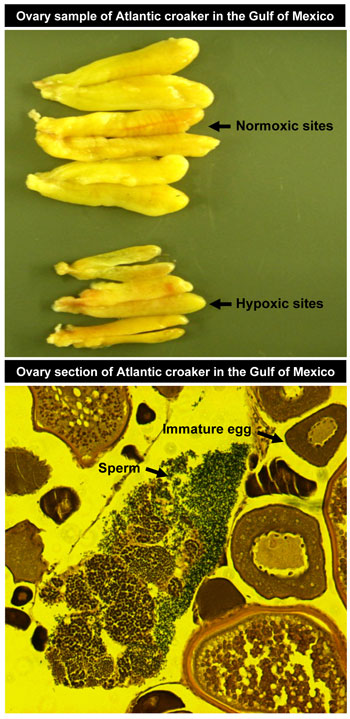AUSTIN, Texas — Atlantic croaker living in the large Gulf of Mexico “Dead Zone” exhibit severe reproductive impairment with potential long-term impacts on the fish’s population abundance, researchers from The University of Texas at Austin’s Marine Science Institute have found.
Males and females were found to produce dramatically fewer sperm and eggs. In addition, females in the hypoxic Dead Zone waters were masculinized — some 20 percent actually produced sperm in their ovaries. The sex ratio was also heavily skewed toward males in the hypoxic area.
“This is the first evidence of impairment of reproductive output across a wide region in a fish population inhabiting a hypoxic coastal zone,” says Peter Thomas, professor of marine science.

Top: Ovaries in Atlantic croaker are smaller if the fish are found in the Dead Zone's hypoxic waters. Bottom: Female croaker were found to produce sperm in hypoxic water. Image credit: The University of Texas at Austin
Thomas and his coauthor, marine scientist Saydur Rahman, published their research in Proceedings of the Royal Society B.
The occurrence of low oxygen (hypoxic) waters in coastal regions worldwide has increased dramatically over the past 25 years, but its impact on marine animals is just beginning to be understood.
The northern Gulf of Mexico “Dead Zone,” off the coast of Louisiana, is the second largest seasonal hypoxic zone in the world, averaging 6,447 square miles annually. Coastal areas affected by hypoxia are often economically and environmentally important for maintaining fish populations and fisheries.
Thomas and Rahman collected and studied fishes from sites throughout the northern Gulf of Mexico hypoxic zone and compared them with fishes collected from areas with normal oxygen levels.
Masculinization of the female croaker and other reproductive problems were associated with declines in neuroendocrine function and ovarian and brain expression of an enzyme called aromatase that converts androgens (male sex hormones) to estrogens (female sex hormones). This was found to be the case in field and laboratory experiments.
“Our results show that ovarian masculinization is a specific response to hypoxia and is due to decreased aromatase activity,” Thomas says.
*Source: The University of Texas at Austin
